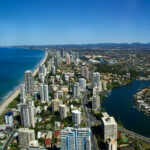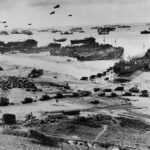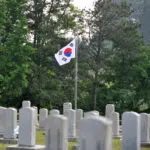D-Day, observed annually on June 6, brings overwhelming memories of the brave men and women who fought a strategically planned and well-executed battle that ultimately led to the end of the Second World War. More than 75 years after the end of World War II, these memories remain fresh to the over 300,000 living U.S. veterans of the war. The rest of us look to their legacy and the rich history of events told through museums and memorials. There is not a more important time than today for us to remember and honor them as we reflect on D-Day, June 6, 1944.
History of D-Day
The morning of June 6, 1944, American troops and their allied forces landed on the beaches of Normandy, France in an invasion, code-named Operation Overlord, during World War II, which began the liberation of France, and ultimately other areas of Europe, from Hitler’s Nazi regime. This day, known as D-Day, and the strategically planned landing of 156,000 British, Canadian and American troops at 6:30 A.M. on the five beaches of Normandy was code-named Operation Neptune.
Earlier in the morning of June 6, 24,000 airborne troops were dropped into battle by parachute in order to close exits and overtake bridges slowing the advancement of Nazi reinforcements. Troops entering the beaches by land and sea were met with Hitler’s ‘Atlantic Wall,’ 2,400 miles of bunkers, landmines, and beach obstacles (metal tripods, barbed wire, and wooden stakes) established in anticipation of a French coast invasion. Nazis planted 4 million landmines along Normandy beaches.
Planning for our invasion of German-occupied France began in 1942. In an attempt to mislead the Germans and maintain the secrecy of the details of the D-Day invasion, the Allies conducted a military deception, code-named Operation Bodyguard. It included fake radio transmissions, double agents, and a ‘phantom army’ commanded by American General George Patton.
June 5 was originally chosen as D-Day due to predictions of weather and high tide, based on the phase of the moon. Bad weather conditions ultimately interfered with the established plans and D-Day moved to June 6.
Ultimately, over 4,400 identified soldiers, sailors, airmen, and coastguardsmen died on D-Day with an estimated 5,000 or more were lost at sea, in an air battle, or otherwise were not identified. Their sacrifice and the valiant efforts of all troops turned the tide of the entire war that day.
D-Day timeline
Following the attack on Pearl Harbor, President Roosevelt declares war on Japan in what is known as the Pearl Harbor speech where he quotes the prior day, December 7, as “a day which will live in infamy.”
The United States begins planning a cross-channel attack of German troops in France with British allies.
The first national memorial dedicated to all who served in World War II is authorized by President Bill Clinton in 1993; it opens to the public in 2004.
At the 75th anniversary of the storming of Normandy beaches, over 300,000 veterans are still alive to be honored.
D-Day FAQs
What does the ‘D; in D-Day stand for?
The Army and The National World War II Museum have given two explanations. First, it is simply a designation used to indicate the day of an operation as well as the days leading up to it and after it. For example, June 5, 1944, would have been D-1 and June 6, D-Day. Second, ‘D’ stands for ‘departed date’, meaning the date an operation began. So in the case of WWII, there were multiple D-Days for the various amphibious assaults.
How many soldiers were missing in action?
At the end of the war, around 79,000 U.S. soldiers were unaccounted for, either missing in action (MIA) or believed to be lost at sea.
What type of boat was used to storm Normandy?
Higgins boats were used to transport soldiers in every major amphibious assault of World War II. These landing crafts were built in New Orleans, Louisiana by Higgins Industries’ 30,000 employees. General Dwight D. Eisenhower once stated that Andrew Jackson Higgins, owner of Higgins Industries, was “the man who won the war for us.”
Ways to Observe D-Day
Thank a veteran
Our World War II veterans, as with all veterans of our active military, sacrificed greatly during their times of battle. It is difficult for those of us who have not served our country in the same manner to understand the full measure of their service and sacrifice. But, today, we listen, learn and thank the men and women who protected our freedom at such a critical time in our world’s history.
Visit the museum in New Orleans
Opening in 2000, the World War II Museum in New Orleans, Louisiana offers briefings throughout the day explaining events as they occurred in 1944. Step onto one of the boats that took our soldiers to the beaches of Normandy.
Watch a WWII movie
Over 50 movies have been created depicting aspects of World War II — detailing battles, showcasing heroes, and remembering victims of the Holocaust. You can learn about the war and the events at Normandy from a variety of angles to understand the true scope of this war and what our victory has meant to the world.
5 Interesting Facts About D-Day
The weather
Predicted poor weather conditions caused General Eisenhower to delay the start of the battle by one day to June 6.
The son of a president
Brigadier General Theodore Roosevelt Jr., son of President Theodore Roosevelt, was the oldest soldier to land on the beaches of Normandy at 56 — he was posthumously awarded with the Medal of Honor for his heroic actions at Utah beach.
Setting the stage
A staging area was established in England, the launch site of Operation Overlord, where the U.S. military stocked seven million tons of supplies, including 450,000 tons of ammunition.
The swimming Sherman
These tanks were operational in water and on land and were used on all five beaches to support the landing troops on D-Day.
The five beaches
Operations sectioned the 50 miles of coastline into five beaches given code names: Utah, Omaha, Gold, Juno, and Sword.
WHY WE HONOR D-DAY
It was a key moment in our world’s history
Looking back at the circumstances surrounding the Second World War, we understand the criticality of the outcome. Historians’ views of what could have happened if the Allied forces had not been victorious paint the trajectory of the world in a clearly different light.
We love our freedom
The ongoing protection of our freedom is paramount to the American dream. Our Constitution and several of its amendments spell out our specific freedoms, which is what sets us apart from other countries around the world. Our freedom of religion, speech, the press, and to assemble and petition are only a few that are protected daily by our active military and those who fought before them.
We love to honor real-life heroes
Not all heroes wear capes — some wear camo. Numerous stories continue to be told of men and women who endured the unthinkable and achieved the unbelievable during D-Day and World War II. Their stories are inspiring and allow us to put names and faces to the stories we heard in history class.
D-Day dates
| Year | Date | Day |
|---|---|---|
| 2026 | June 6 | Saturday |
| 2027 | June 6 | Sunday |
| 2028 | June 6 | Tuesday |
| 2029 | June 6 | Wednesday |
| 2030 | June 6 | Thursday |

























